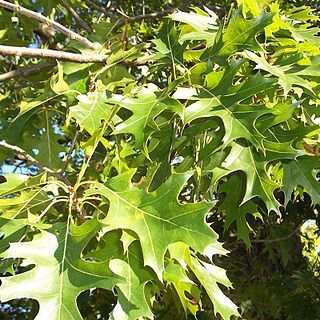Trees , deciduous, to 20 m; lower trunk often with stubs of dead branches. Bark dark gray-brown, shallowly fissured, inner bark orangish. Twigs dark reddish brown, (1-)1.5-3 mm diam., glabrous. Terminal buds dark reddish brown, ovoid, 3-5 mm, often conspicuously 5-angled in cross section, usually silvery-or tawny-pubescent toward apex. Leaves: petiole 20-50 mm, glabrous. Leaf blade elliptic, 70-130 × 50-100 mm, base obtuse to truncate, margins with 5-7 deep lobes and 15-55 awns, lobes distally expanded, sinuses usually extending more than 1/2 distance to midrib, apex acute; surfaces abaxially glabrous except for minute axillary tufts of tomentum, adaxially glossy light green, glabrous, secondary veins raised on both surfaces. Acorns biennial; cup narrowly turbinate to deeply cup-shaped, 6-11 mm high × 10-19 mm wide, covering 1/3-1/2 nut, outer surface reddish brown, puberulent, inner surface light brown, glabrous, rarely with ring of pubescence around scar, scales with straight or slightly concave margins, tips tightly appressed, obtuse or acute; nut ellipsoid to ovoid, rarely subglobose, 10-20 × 9-15 mm, occasionally striate, glabrous, occasionally with 1 or more faint rings of fine pits at apex, scar diam. 4-8 mm.
More
Middle-sized tree; twigs soon glabrescent; lvs glabrous except for small tufts of stellate hairs in the vein-axils beneath; lateral lobes 2–3 pairs, separated by rounded sinuses, usually extending more than half way to the midvein, usually widened and several-toothed distally; acorn-cup turbinate, 9–14 mm wide, smooth inside, with closely appressed, puberulent scales, covering a third of the 12–20 mm nut. Dry upland soil; s. Mich. and adj. O. to Minn. and sw. Ont. and Mo. Possibly better included in no. 29 [Quercus coccinea Münchh].
A deciduous tree. The bark is shallowly furrowed. It grows 15-21 m high. The trunk is 30-80 cm across. The leaves are 7-12 cm long, The leaves have lobes. These are often constricted towards the base. The leaf stalk is slender and 3.5-5 cm long. The twigs are reddish brown and hairy when young. The acorns and 12-18 mm long. The cup is 10-15 mm across. It encloses one third of the nut. It tapers to a stalk like cup.
Dry to moist siliceous to argillaceous woods. Dry sandy sites, rarely on moderately mesic slopes or uplands; at elevations from 150-500 metres. The best specimens are found in rich well-drained soils, especially those containing clay.
More
It is a temperate plant. It is native to Canada and the north of the United States. It grows on sandy soils in open disturbed places. It suits hardiness zones 5-10.


